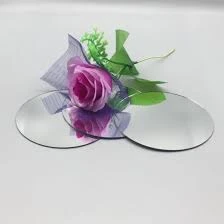

The Benefits and Applications of Toughened Mirror Glass
In the world of modern design and architecture, materials play a crucial role in determining not only aesthetics but also functionality and safety. Among these materials, toughened mirror glass has emerged as a popular choice for various applications. This innovative product combines the reflective qualities of traditional mirrors with enhanced durability and safety features, making it ideal for both residential and commercial use.
Toughened mirror glass, often referred to as tempered mirror glass, is produced through a process of extreme heating and rapid cooling. This manufacturing technique significantly increases the strength of the glass, making it much more resilient to impact, temperature changes, and stress. As a result, toughened mirror glass can withstand forces that would cause regular glass to shatter. This additional strength makes it an excellent choice for high-traffic areas or for installations where safety is a priority.
One of the most significant advantages of toughened mirror glass is its safety features. In the event of breaking, toughened glass shatters into small, blunt pieces rather than sharp shards. This property reduces the risk of injury, making it particularly suitable for environments such as schools, hospitals, and public buildings, where safety is of utmost importance. Moreover, its durability means that it is less likely to break during installation or everyday use, further enhancing its safety profile.
Aesthetic appeal is another crucial factor that has contributed to the popularity of toughened mirror glass. Available in a variety of finishes and thicknesses, toughened mirrors can be tailored to fit any design need. They can be used to create stunning feature walls, decorative accents, or even functional surfaces like bathroom mirrors and kitchen backsplashes. Their reflective quality not only adds depth and light to a space but also creates an illusion of larger areas, which is especially beneficial in smaller or more confined environments.

In addition to its aesthetic and safety benefits, toughened mirror glass is also highly versatile. It can be utilized in various applications beyond mere decoration. For instance, toughened mirror glass is increasingly used in the furniture industry, where it can be applied to tables to create a modern and sleek look. It is also used in retail displays, allowing products to be shown off in an engaging manner while providing visual interest to the overall presentation.
Another remarkable application of toughened mirror glass is in the field of interior design. Designers often use it to add a touch of elegance and sophistication to spaces. From contemporary homes to luxurious hotels, toughened mirror glass can enhance the overall ambiance. Its resistance to wear and tear, coupled with its aesthetic appeal, makes it a preferred choice for designers who seek both beauty and durability.
Additionally, the reflective properties of toughened mirror glass can contribute to energy efficiency. By reflecting light, these mirrors can help reduce the need for artificial lighting, leading to lower energy costs. This eco-friendly aspect makes toughened mirror glass an attractive option for environmentally conscious consumers and businesses.
As the demand for tougher and safer materials continues to rise, toughened mirror glass stands out as a solution that meets these needs while also providing beauty and versatility. Whether used in residential homes, commercial buildings, or unique artistic installations, it demonstrates a perfect blend of functionality and style.
In conclusion, toughened mirror glass is not just a simple reflective surface, but a sophisticated material that enhances both safety and design. Its applications are vast and varied, addressing the modern consumer's need for durability without compromising on aesthetic value. As manufacturers continue to innovate and improve the technology behind toughened glass, we can expect to see even more exciting developments in this field, making toughened mirror glass an essential component of contemporary design and architecture.